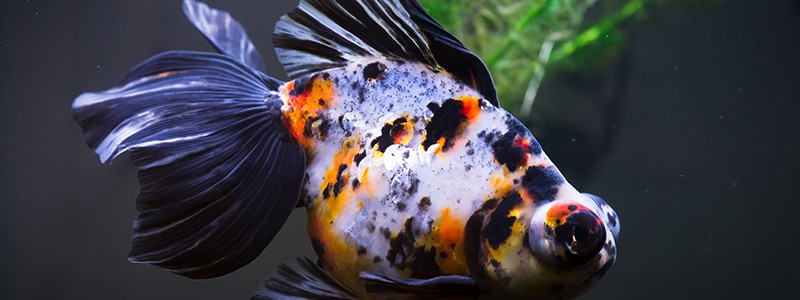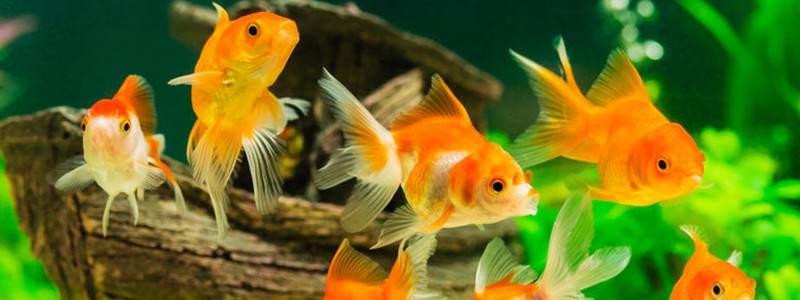Something that I have noticed over the years is that Goldfish are a popular choice of fish. This seems to be because they are particularly easy to take care of. Of course, they are nice to look at too. Whether you get a gold, black, or silver Goldfish, you are bound to look forward to caring for it for many years to come. Keeping your Goldfish healthy is undoubtedly a priority to you. Acting promptly when you notice unusual behaviors is important to the health of your fish. One thing to look out for is color changes in your fish, especially if it starts to turn black.
Why do Goldfish turn black? A Goldfish can change color for a number of reasons, usually due to aquarium conditions. Some of the reasons Goldfish turn black are:
- A natural color change due to a lack of light
- High levels of ammonia in the tank
- Infestation of Blackspot disease
- Genetics
- The size and stability of the tank
It can be difficult to tell when a fish is having a hard time. Unlike other pets, evidence of ill health is often not very easy to note with a fish that is swimming around a tank. Fish do not demand nearly as much time and attention as say a cat or a dog, so you would be forgiven if you do not notice a problem as soon as it crops up. Of course, when a fish turns black, it is a clear sign that something unusual is happening to it. And that needs your immediate attention. Do you want to learn how the above-mentioned conditions can result in a Goldfish turning black? I certainly did, so I took the time to do a bit of digging for info. Read on to learn for yourself.
5 Reasons Why Goldfish Turn Black | What Makes Goldfish Turn Black
You might be concerned about the health of your fish if it is turning black. You might wonder if it is really something to worry about. What should you do? What is the next step? To find out, you need to understand the possible underlying causes of the problem. Once you know what the cause is, you can take steps toward rectifying the problem and nursing your fish back to health. In some instances, there’s nothing you can really do. Let’s take a closer look at each of the possible reasons why your fish could be going through a color change.
1. Your Goldfish Can Turn Black Due to Natural Color Change from a Lack of Light.
Where is your fish tank situated in the home? Is it in a dark corner? Is the room well lit? It is important to take a look at the tank’s position as this could affect the health of your fish. In some instances, I have heard of people panicking over a color change in their Goldfish, only to find that their fish is doing just fine. The thing about Goldfish is that the cells in their skin produce a dark pigment called melanin. When the fish produces more melanin, it will appear darker, or even start to turn black. This is a natural process due to the melanin cells working. When exposed to a decent amount of natural light, your fish should maintain its regular expected color, but if it is placed in a dark room or is without exposure to a decent amount of natural light, the fish’s skin might start to produce extra melanin. The result is the appearance of dark or black areas showing up on the body of the fish, but it can also be seen on the fins too.
What can you do if your Goldfish is turning black from lack of natural light exposure? You can remedy the situation by repositioning the tank in an area that receives some natural light. Or you could open the curtains and blinds. Fish like a little light too. Note that they do not particularly need or like direct sunlight, so you do not have to put your home aquarium in the sun.
2. High Levels of Ammonia in the Tank Could Change a Goldfish Black
How clean do you keep your fish tank? Do you clean it thoroughly on a regular basis or do you wait for the water to get very murky before you take action? It is a good idea to set a cleaning schedule in place, for the health of your fish. Most people do not know this, but a dirty fish tank can lead to the death of your fish. Ammonia is actually toxic to fish and if the levels are consistently high in the tank, it can lead to serious health problems. Ammonia levels in the fish tank are affected by how much waste is in the tank. Ammonia is a by-product of waste such as excretion, excess food, and general dirt and algae. When the ammonia levels are high, the fish can experience skin damage, and when this happens, the Goldfish turns black. The fish turns black because its skin is being burned by ammonia.
What can you do if your Goldfish is turning black from high levels of ammonia in the tank? The first step to helping your fish heal in this type of situation is to give the tank a thorough cleaning. Thereafter, make sure that you keep the tank clean going forward. As the fish heals, the black markings should start to fade. When the fish has made a full recovery, it should return to its original color. To keep ammonia levels at bay, regularly clean the tank and do not over-feed your fish as excess rotting food leads to an increase in ammonia levels.
3. Blackspot Disease Can Cause a Goldfish to Turn Black.
Goldfish can turn black if they contract a disease, but do not panic. If your Goldfish is turning black – it does not always mean that it has contracted a disease. In very rare instances, a Goldfish that is turning black is suffering from Blackspot disease. What is Blackspot disease? This is a disease that is carried by water snails. The eggs of the parasite burrow deep into the skin of the Goldfish and form protective hard cysts which are black in color. The result of this infestation is the appearance of black spots all over the Goldfish.
What can you do if your Goldfish is turning black from Blackspot disease? The best way to keep this type of problem at bay is to remove snails from your tank either permanently or temporarily. Temporary removal from the tank breaks the parasite’s life cycle which will boost the healing of your Goldfish.
4. Genetics Can Cause a Goldfish to Turn Black.
Where did you get your Goldfish? Did you buy it from a pet store or do you stock your home aquarium with purebred fish species bought from an official breeder? This could really make all of the difference. Buying purebred pets is not only something that is practiced by a cat, dog, and horse lovers. Breeding works much the same with fish. When you buy a Goldfish with a guaranteed color from a reputable breeder, your pet should remain consistently the expected color. However, if you opt to buy a fish that is potentially a mixed breed (this happens when you buy Goldfish from regular pet shops), then you might buy a fish that has the genes in it to turn black. If a Goldfish is going to experience a color change, this will usually happen within the first year of life, but it can happen at a later stage too. In most instances, the entire fish does not turn black. Instead, the fish gets darker or black patches to develop all over it.
There really is not anything you can do if your fish is turning black because of genetics.
5. The Size & Stability of the Tank Can Result in a Goldfish Turning Black.
If your fish is turning black, there could be a number of reasons at play. Maybe you did not start things off correctly from the beginning. The fish tank that you start off with could have an impact on your success as a fish keeper. Always opt for a bigger tank as this means your fish will have more oxygen available to them and the risk of high levels of ammonia is slightly reduced.
Goldfish thrive when provided with stable water conditions. This means that your water temperature needs to be ideal, there needs to be sufficient space, the tank needs enough natural light exposure, and the tank must be kept clean.
Final Words
It’s interesting to note that there are a handful of reasons why your Goldfish may be changing color. Sometimes it is not what you think it is. Hopefully, you have a bit more insight into the underlying reason why your Goldfish might be turning black. If you can’t quite pinpoint the problem, it is best to consult with your local vet, to ensure the health and safety of your fish.





